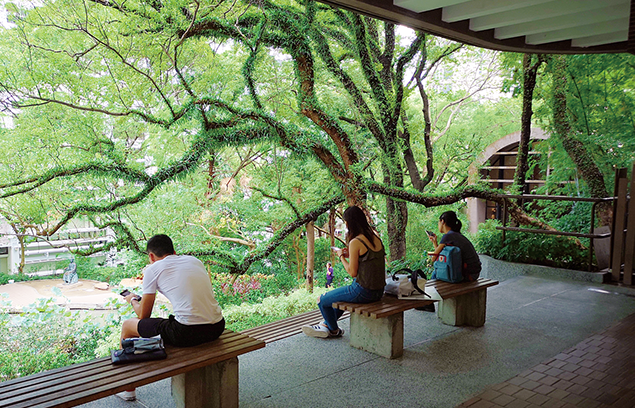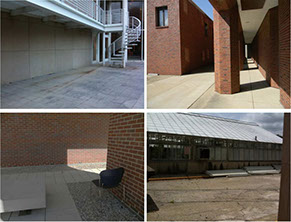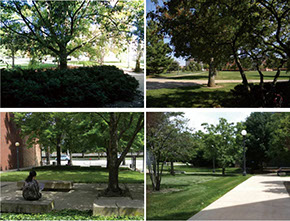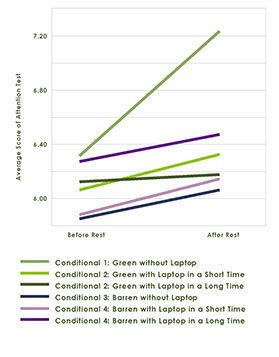THE SCREEN EFFECT TROUNCES THE
GREEN EFFECT
Taking a break in a green environment has long been known to give the brain a rest and improve attention. But if that break is spent staring at a screen, you may as well be surrounded by brick walls, a new study finds.
Dr Bin Jiang pays close attention to the impact that surroundings have on people, as befits the Head of the Virtual Reality Lab of Urban Environments and Human Health in the Faculty of Architecture. But that two-part interaction has become complicated by a third factor – the virtual world and its increasing dominance of people’s time. The global population will spend the equivalent of one billion years online this year, according to the World Health Organization. In response, Dr Jiang and fellow landscape architects in the US recently studied how this obsession with virtual reality is affecting people’s encounters with their physical environment.
The study compared the before-and-after attentional function of participants who were given cognitive and attention tests broken up by a 15-minute break. The key was what happened during the break. One group was sent to a barren concrete area, the other group to a green area with trees. Within each group, half were told to leave their laptops behind and the other half were told to bring them and use them as they normally would for recreational uses, such as checking social media or watching YouTube videos. The results were rather depressing for anyone who thinks these activities constitute a ‘break’ from work.
“Being in a green environment without a laptop was the only treatment that had a significant enhancement on attention function. Using electronic devices when taking a break in this setting substantially counteracts that benefit,” Dr Jiang said.
And that effect can undermine the ability to pay attention because green environments have been shown in numerous previous studies to boost attention power.

![]() Watching the wind blow through
Watching the wind blow through
trees or an insect crawl through grass
allows the mind to wander and lets that
part that engages in ‘hard fascination’
take a break. ![]()
Dr Bin Jiang
Attention deficit
“Attention is a critical resource. Think of how many people are killed in car accidents because drivers lose attention or don’t have the mental energy to accurately control their vehicles. If you look at factories in China and developing countries, how many people get injured because they are tired and don’t have the energy to focus attention on operating the machine correctly? Any occupation that requires paying close attention can be affected,” he said.
In addition, there was a significant attentional difference between those who spent more than 50 per cent of their break looking at a screen and those who spent less.
The researchers proposed that the effect of the screens might be due to their interference with ‘soft fascination’, which tends to free the mind. “Watching the wind blow through trees or an insect crawl through grass allows the mind to wander and lets that part that engages in ‘hard fascination’ take a break,” Dr Jiang said. On the other hand, using electronic devices involves hard fascination so there is no opportunity for such a break.
The obvious response to these findings is to put down electronic devices when taking a break and soak in some green scenery, but there are also profound implications for landscape architects.
The study was published in Environment and Behaviour and attracted considerable attention around the world, being covered by 17 media outlets in the US, Belgium, the Netherlands, Mainland China, Hong Kong, Malaysia and India.

We are physically in green spaces but often mentally still occupied by the screens.


The study compared the before-and-after attentional function of participants who were given cognitive and attention tests broken up by a 15-minute break. Participants were randomly assigned to the barren settings (left) and green setting (right) during the break.
Redefining ‘place’
“The idea of place has been redefined and blurred by the powerful interruption, some would say aggression, of digital devices. Fifteen years ago, you would go to a park or street or plaza and that physical environment was the dominating setting for your physical and mental state. Now, with your electronic screens, physically you are in that place but mentally you are in another place,” he said.
“As designers, when we create a place, we are no longer competing with other designers who create other physical places. Our competitors are computer scientists and engineers who are deliberately designing digital environments that drag away people’s attention. This makes our job even more challenging. We have to make a greater effort to get people to pay attention to the landscape and the environment, let their hands catch insects, their eyes move around, and have surprising features like pop fountains, so they will put their phones aside.”
Changes in attentional functioning after six rest conditions – only the ‘Green without Laptop’ group yielded significant attention enhancement.

Back
Home
November 2018
Volume 20
No. 1

